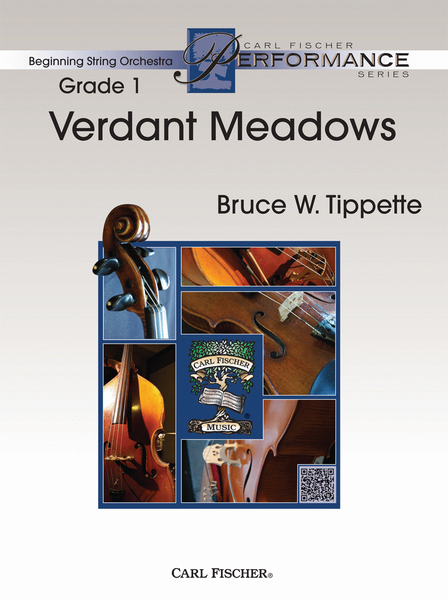Verdant Meadows
-
Ships in 1 to 2 weeks
Details
Description
SKU: CF.BAS78
Composed by Bruce W. Tippette. Beginning String Orchestra (BAS). Set of Score and Parts. With Standard notation. 8+2+8+5+5+5+2+8 pages. Duration 2 minutes, 38 seconds. Carl Fischer Music #BAS78. Published by Carl Fischer Music (CF.BAS78).ISBN 9781491151235. UPC: 680160908738. 9 x 12 inches. Key: G major.
The imagery of a lush, green meadow helps set the stage for Verdant Meadows. This simple, yet harmonically adventurous composition alternates between legato melodies and staccato harmonies. Following a climactic moment, a peaceful resolution hearkens back to earlier material and ends the piece with a Maestoso section.
Imagine taking a gentle stroll through a lush, green meadow, filled with wildlife and vegetation. This imagery helps set the stage for the melodic content of Verdant Meadows. In the key of G major (and sometimes E minor), this simple, yet harmonically adventurous composition alternates between soaring legato melodies and staccato harmonies. Following the broadly climactic moment, a peaceful resolution hearkens back to earlier material and ends the piece with a wonderful Maestoso section. .
Imagine taking a gentle stroll through a lush, green meadow, filled with wildlife and vegetation. A This imagery helps set the stage for the melodic content of Verdant Meadows. In the key of G major (and sometimes E minor), this simple, yet harmonically adventurous composition alternates between soaring legato melodies and staccato harmonies. A Following the broadly climactic moment, a peaceful resolution hearkens back to earlier material and ends the piece with a wonderful Maestoso section. A .
Imagine taking a gentle stroll through a lush, green meadow, filled with wildlife and vegetation. A This imagery helps set the stage for the melodic content of Verdant Meadows. In the key of G major (and sometimes E minor), this simple, yet harmonically adventurous composition alternates between soaring legato melodies and staccato harmonies. A Following the broadly climactic moment, a peaceful resolution hearkens back to earlier material and ends the piece with a wonderful Maestoso section. A .
Imagine taking a gentle stroll through a lush, green meadow, filled with wildlife and vegetation. This imagery helps set the stage for the melodic content of Verdant Meadows. In the key of G major (and sometimes E minor), this simple, yet harmonically adventurous composition alternates between soaring legato melodies and staccato harmonies. Following the broadly climactic moment, a peaceful resolution hearkens back to earlier material and ends the piece with a wonderful Maestoso section. .
Imagine taking a gentle stroll through a lush, green meadow, filled with wildlife and vegetation. This imagery helps set the stage for the melodic content of Verdant Meadows. In the key of G major (and sometimes E minor), this simple, yet harmonically adventurous composition alternates between soaring legato melodies and staccato harmonies. Following the broadly climactic moment, a peaceful resolution hearkens back to earlier material and ends the piece with a wonderful Maestoso section.
Imagine taking a gentle stroll through a lush, green meadow, filled with wildlife and vegetation. This imagery helps set the stage for the melodic content of Verdant Meadows. In the key of G major (and sometimes E minor), this simple, yet harmonically adventurous composition alternates between soaring legato melodies and staccato harmonies. Following the broadly climactic moment, a peaceful resolution hearkens back to earlier material and ends the piece with a wonderful Maestoso section. .
About Carl Fischer Beginning String Orchestra Series
This series of Grade 1 pieces is designed for first year string groups. The pieces in this series are characterized by:
- Limited parts (often 2nd violin and viola are the same part, cello and bass are same part)
- Limited keys and rhythms - only simple 8th note patterns
- Limited independence of parts
- Playable after limited study time
- First position and natural bowings
- Piano for rehearsal and reinforcement

 Share
Share